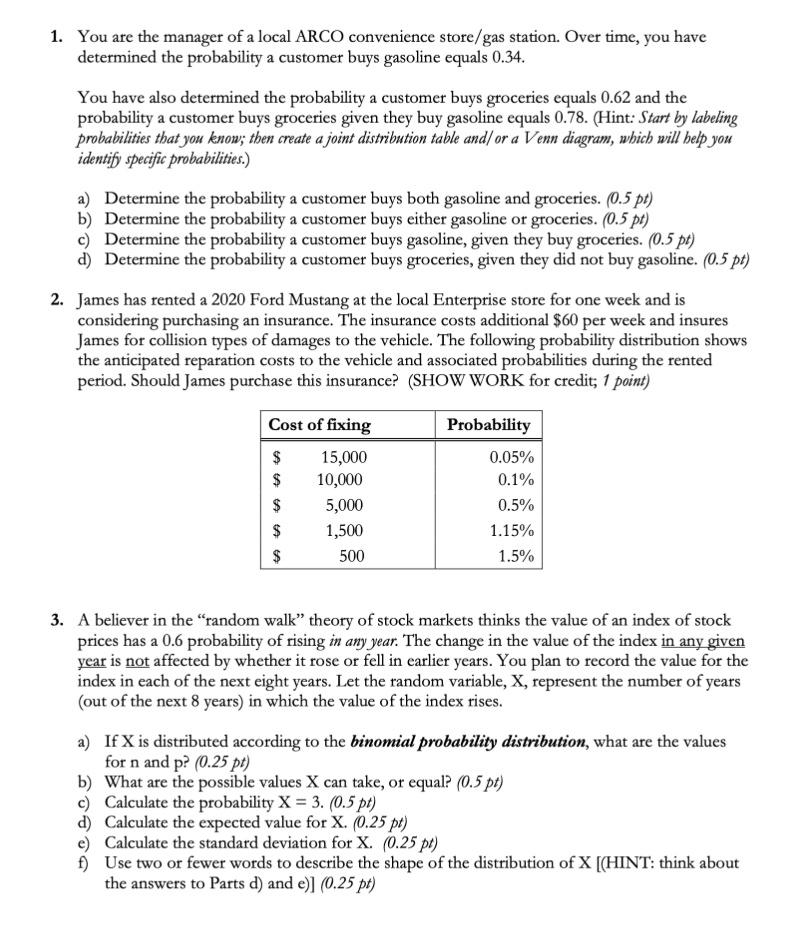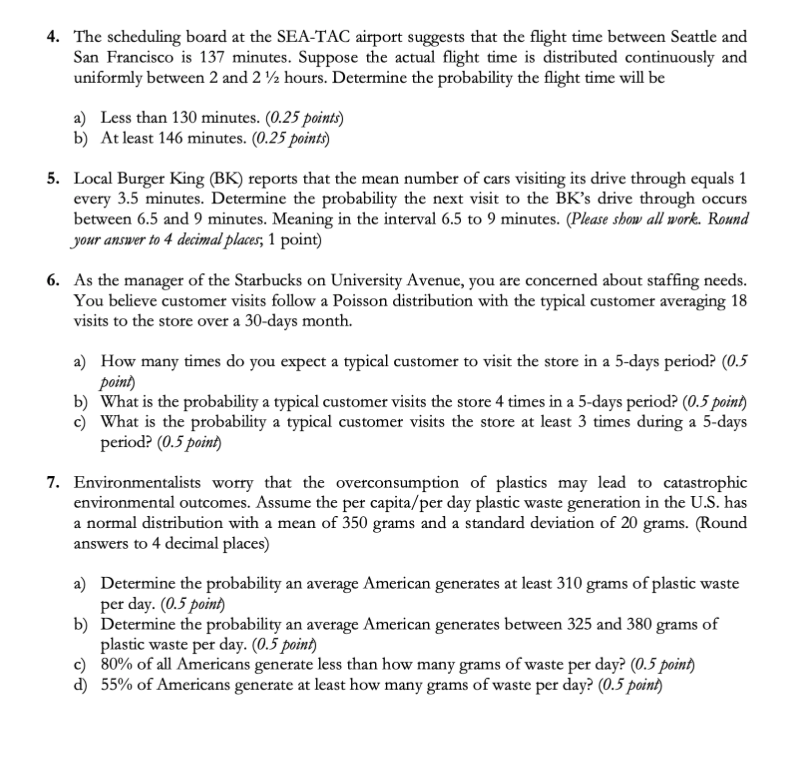1. You are the manager of a local ARCO convenience store/gas station. Over time, you have determined the probability a customer buys gasoline equals 0.34. You have also determined the probability a customer buys groceries equals 0.62 and the probability a customer buys groceries given they buy gasoline equals 0.78. (Hint: Start by labeling probabilities that you know; then create a joint distribution table and/ or a Venn diagram, which will help you identify specific probabilities.) a) Determine the probability a customer buys both gasoline and groceries. (0.5 pt) b) Determine the probability a customer buys either gasoline or groceries. (0.5 pt) c) Determine the probability a customer buys gasoline, given they buy groceries. (0.5 pt) d) Determine the probability a customer buys groceries, given they did not buy gasoline. (0.5 pt) 2. James has rented a 2020 Ford Mustang at the local Enterprise store for one week and is considering purchasing an insurance. The insurance costs additional $60 per week and insures James for collision types of damages to the vehicle. The following probability distribution shows the anticipated reparation costs to the vehicle and associated probabilities during the rented period. Should James purchase this insurance? (SHOW WORK for credit; 1 point) Cost of fixing Probability 15,000 0.05% 10,000 0.1% 5,000 0.5% 1,500 1.15% 500 1.5% 3. A believer in the "random walk" theory of stock markets thinks the value of an index of stock prices has a 0.6 probability of rising in any year. The change in the value of the index in any given year is not affected by whether it rose or fell in earlier years. You plan to record the value for the index in each of the next eight years. Let the random variable, X, represent the number of years (out of the next 8 years) in which the value of the index rises. a) If X is distributed according to the binomial probability distribution, what are the values for n and p? (0.25 pt) b) What are the possible values X can take, or equal? (0.5 pt) Calculate the probability X = 3. (0.5 pt) ) Calculate the expected value for X. (0.25 pt) e) Calculate the standard deviation for X. (0.25 pt) f) Use two or fewer words to describe the shape of the distribution of X [(HINT: think about the answers to Parts d) and e)] (0.25 pt)4. The scheduling board at the SEA-TAC airport suggests that the flight time between Seattle and San Francisco is 137 minutes. Suppose the actual flight time is distributed continuously and uniformly between 2 and 2 1/2 hours. Determine the probability the flight time will be a) Less than 130 minutes. (0.25 points) b) At least 146 minutes. (0.25 points) 5. Local Burger King (BK) reports that the mean number of cars visiting its drive through equals 1 every 3.5 minutes. Determine the probability the next visit to the BK's drive through occurs between 6.5 and 9 minutes. Meaning in the interval 6.5 to 9 minutes. (Please show all work. Round your answer to 4 decimal places; 1 point) 6. As the manager of the Starbucks on University Avenue, you are concerned about staffing needs. You believe customer visits follow a Poisson distribution with the typical customer averaging 18 visits to the store over a 30-days month. a) How many times do you expect a typical customer to visit the store in a 5-days period? (0.5 point) b ) What is the probability a typical customer visits the store 4 times in a 5-days period? (0.5 point) c) What is the probability a typical customer visits the store at least 3 times during a 5-days period? (0.5 point) 7. Environmentalists worry that the overconsumption of plastics may lead to catastrophic environmental outcomes. Assume the per capita/per day plastic waste generation in the U.S. has a normal distribution with a mean of 350 grams and a standard deviation of 20 grams. (Round answers to 4 decimal places) a) Determine the probability an average American generates at least 310 grams of plastic waste per day. (0.5 point) b) Determine the probability an average American generates between 325 and 380 grams of plastic waste per day. (0.5 point) C) 80% of all Americans generate less than how many grams of waste per day? (0.5 point) d) 55% of Americans generate at least how many grams of waste per day? (0.5 point)








